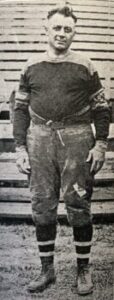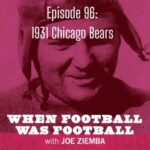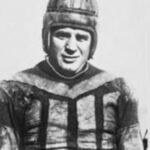On November 6, 1927, a few thousand of his closest friends gathered to honor Chicago Cardinals’ lineman Willis Brennan. But Willis Brennan was much more than a football player. In fact, if you consider some of the landmark events of Chicago in the 1920s, chances are Willis Brennan was there…such as the birth of the NFL in 1920, Red Grange’s first professional game in 1925, the infamous Leopold-Loeb murder case, and the gang wars on the south side of Chicago. For Brennan was not only a respected gridiron giant, he was also one of Chicago’s finest.
Being a full-time policeman while playing both ways for the early Cardinals was never an issue for Willis Brennan. Born on February 12, 1893, in Chicago, Brennan grew into a fortress of a lineman at 6’ tall and 214 lbs.—small by today’s standards, but a monster over 100 years ago! Brennan loved sports and excelled in football, but was not destined to shine on a collegiate gridiron.
Instead, Brennan found a home in the sandlot competition in Chicago and carefully planned his future by aligning himself with the Chicago Police Department, where he was a solid, and reliable, asset.
Twice Named An All-Pro
On the football side, Brennan was in the trenches for eight seasons (1920-1927) with the Cardinals where he captured a pair of “All-Pro” honors at the guard position. He was well-respected, even during the “off” seasons for the Cardinals as noted in a 1927 article in the Hammond Times which discussed the team’s personnel:
“At tackle and end the Cards are well-protected, but with the exception of Willis Brennan, the south siders lack any outstanding performers in the center of the line.”
However, when Brennan joined the Cardinals in 1920, he had already stashed away a few years of professional experience as a member of the Cornell-Hamburgs club in Chicago. In the pre-NFL days, these teams recruited former college and high school luminaries to compete for roster spots.
The clubs were well-organized, competed with a properly arranged schedule, and took their games and practices very seriously. It was estimated that Brennan began his “pro” football career around 1907 or 1908 when he was still just a teenager.

Driscoll Knocked Out By Brennan
The Daily Southtown wrote: “Brennan began his service with the Cardinals in 1920 after nearly 13 years as a member of strong pro and semi-pro clubs.” During his time with the Cornell-Hamburgs, Brennan was used primarily as a tackle, switching to guard when he was with the Cardinals.
The 1915 Cornells squad was especially tough, outscoring its opponents 216-0 through its first four games on its way to claiming an undefeated season and the so-called “Midwest Championship.”
Bill Finn served as the coach/manager of the Cornells and was on hand during Brennan’s most famous game with the Cornells. During a 13-3 loss against Hammond in 1917, Brennan broke through the defensive line and hammered future Cardinals’ teammate Paddy Driscoll with a vicious tackle. As the Hammond Times stated: “Driscoll played quarterback for Hammond and put up a wonderful game up to the third period when…he was knocked out by a tackler, Willis Brennan of the Cornell-Hamburgs.”
Apparently, Driscoll took a few minutes to recover from Brennan’s on-field assault and then suddenly, and surprisingly, booted a 55-yard drop kick field goal. “He astounded the fans by booting a perfect goal from past the center of the field. The ball sailed nearly twenty yards before landing back of the goal posts,” reported the Hammond Times.
Later, it was revealed that Driscoll had no recollection of his massive kick and his teammates admitted that he actually called for a forward pass in the huddle. The Times added: “It was discovered that he had all recollection of the game knocked out of him [by Brennan] when he was hurt.”
Had there been a National Football League at the time, Driscoll’s 55-yarder would have been a league record and would not be equaled until Driscoll did so again in 1924.
Boys Were Unaccustomed To The Fragrance
By the time Brennan joined the Cardinals in 1920 for the inaugural season of the American Professional Football Association, Chris O’Brien managed the Cardinals and recruited the best players from around the south side of Chicago. A full schedule was prepared, the players were placed under contract, and O’Brien even surprised his club with new uniforms according to reporter Rocky Wolfe of the Chicago Tribune…but the players were a bit apprehensive:
“Chris O’Brien gathered the Cardinals together and gave them uniforms, any of which were precisely like the others. The boys objected. They were unaccustomed to the fragrance of new wool and were fearful somebody might accuse them of using perfume!”
Under Brennan’s leadership on the field, that first edition of the Cardinals (then initially known as the Racine Cardinals) compiled a 6-2-2 record in 1920, and the club finished with a winning mark each season through 1925 when the organization was awarded its first NFL championship.
By 1927, Brennan was thought to be the oldest player in the league at the ripe old age of 34 and he was about to call it a day with his football escapades. And that brings us back to the big celebration for Brennan on November 6, 1927.
Perhaps the rigors of NFL travel were getting to Brennan, if not his age when he faced off each week against challengers more than a decade younger in one of the most difficult jobs on the gridiron. Back in the 1920s, remember, there were no jet planes, so if the team played in New York or Philadelphia on a Sunday, there was a stampede back to the train after the game so that the players could arrive back in Chicago after an all-night train ride to report back for their “real” jobs on Monday morning!
7,000 Admirers of Willis Brennan
Anyway, on November 6, the Cardinals hosted a wonderful tribute for Brennan to honor not only his eight seasons with the Cardinals but also his twenty years overall as a player. The Chicago Tribune noted: “Seven thousand friends and admirers of Willis Brennan will gather at Normal Park to honor the veteran Cardinal lineman at the completion of his 20th year of professional football.
A testimonial of the esteem in which he is held by his friends will be presented to Brennan immediately before the game [against the Green Bay Packers]. Preceding the contest, there will be an automobile parade from 37th and Wallace, the headquarters of the old Cornell bunch, to the park.”
Although the game with the Packers ended in a 6-6 deadlock, Brennan would then finish out the season with five more contests (four on the road) as the struggling Cardinals completed the season with a 3-7-1 record in league competition.
Fast and Aggressive Despite His Age
His NFL legacy was already entrenched before the Packers’ game as the Southtown Economist marveled: “During his years of service with the Cards, Brennan has been rated as one of the best guards in the league. He is fast and aggressive despite his age and understands the game thoroughly!”
As his football career was easing away, Brennan continued to be a valuable resource for the Chicago Police Department and accolades followed him on that side of his life as well.
He was cited for numerous accomplishments, such as helping to quell a jail riot in 1919, assisting in the identification and capture of three individuals in a high-profile murder case in 1920, and capturing elusive murderer John Scheck in 1933 who was accused of fatally shooting a police officer inside a courtroom.
Gunman Aimed His Pistol At Brennan
Here’s what happened…
A gun had been smuggled into Scheck’s jail cell and he used that weapon to launch his attempted escape by shooting a policeman who had been stationed inside the courtroom and then attempting to flee the building.
Brennan was inside the building when he heard both the shots and the shouts of alarm and immediately spotted the assailant. As Brennan, still utilizing his football quickness lunged at Scheck, the gunman aimed his pistol at Brennan and slowly squeezed the trigger.
Nothing…
As Brennan moved to immobilize Sheck, he fired the gun three more times at Brennan…
Nothing…
Maybe it was the luck of the Irish, but Brennan successfully subdued Scheck who was later electrocuted for his crimes. Scheck had run out of bullets, and out of luck, when he encountered a determined hero that day by the name of Willis Brennan.
Brennan Ejected The Attorney
The capture of Scheck prompted an all-out war against crime in Chicago which eventually led to the conviction of 213 defendants according to the Chicago Tribune. During this time, Brennan had been working as a detective with the State’s Attorney’s office and helped uncover a massive fraud in 1940 where he utilized both his detective and football skills to solve the case.
After reports were received that a large dairy company in nearby Cicero might be “stealing” city water, Brennan noticed a mysterious pipe that routed the incoming water away from the city meter. As the police were working to identify the cover-up, the lawyer for the company owner objected too strenuously and made the mistake of challenging Brennan.
As the Chicago Tribune reported: “Brennan, a former lineman for the Chicago Cardinals professional football team, ejected the attorney, who was protesting.” Apparently, the lawyer embarked on an unscheduled flight across the room, courtesy of Willis Brennan!
Yet one of the most deplorable crimes in American history, commonly known as the Leopold and Loeb murder case was also part of Brennan’s background. Nathan Leopold and Richard Loeb were two wealthy students at the University of Chicago who murdered a 14-year-old neighborhood boy, basically for the thrill of the act. Leopold and Loeb were eventually captured with the help of Brennan and convicted despite having famed lawyer Clarence Darrow as their legal representative.
Brennan Arrested The Suspect
The Chicago Garfieldian explained the role of Willis in the apprehension of Leopold and Loeb: “Among the many clues that were found to help convict the two youths was the rented car the youths had used in the murder.
This car was found by Willis Brennan and his partner George Homer. After finding the car, they traced it to the youths. Willis and his partner [Homer] were dispatched to pick up Loeb. ‘Loeb was a likable chap,’ Homer recalled. ‘But that Leopold was a smart aleck.
He had a brilliant mind though—was right at the top of his class. Once when Brennan and I took him out for dinner he started talking to the waitress in Spanish and had the girl completely mystified. When the trial was going on we [Homer and Willis] went for days without taking our shoes off.’”
Football Is A Sport He Loves
Although Brennan retired from pro football in 1927, he continued with his police work and later passed away on October 19, 1950, at the young age of 57. After a dual career chasing down both criminals and quarterbacks, Brennan was probably best described by the Southtown Economist on the occasion of that long ago “Willis Brennan Day” in 1927:
“Brennan who is a member of the state’s attorney’s staff police, plays the game of football because it is a sport he loves.”
Thank you for joining us today for this episode of “When Football Was Football” here on the Sports History Network. A special thanks goes out to “Trisha” the grandniece of Willis Brennan and her cousins in Ireland for being with us. Tricia contacted us through our “Chicago Cardinals” Facebook site for information about Willis Brennan and her request led to this program about Mr. Brennan. Thank you, Trisha!
Author and Host - Joe Ziemba
Joe Ziemba is the host of this show, and he is an author of early football history in the city of Chicago. Here, you can learn more about Joe and When Football Was Football, including all of the episodes of the podcast.

Please Note – As an Amazon Associate I earn from qualifying purchases
Resources
More From When Football Was Football
Searching for the “Zest” of the 1931 Chicago Bears
Throughout the history of professional football, every so often you...
Read MoreUgly Passers, Brick Walls, and Feisty Cardinals
Since the Arizona Cardinals are the NFL’s oldest team, with...
Read MoreThe NFL’s Forgotten Gold Medalist!
As usual during the staging of the Summer Olympics, numerous...
Read MorePaddy Driscoll’s Almost Perfect Season
Back at the beginning of the National Football League in...
Read More


